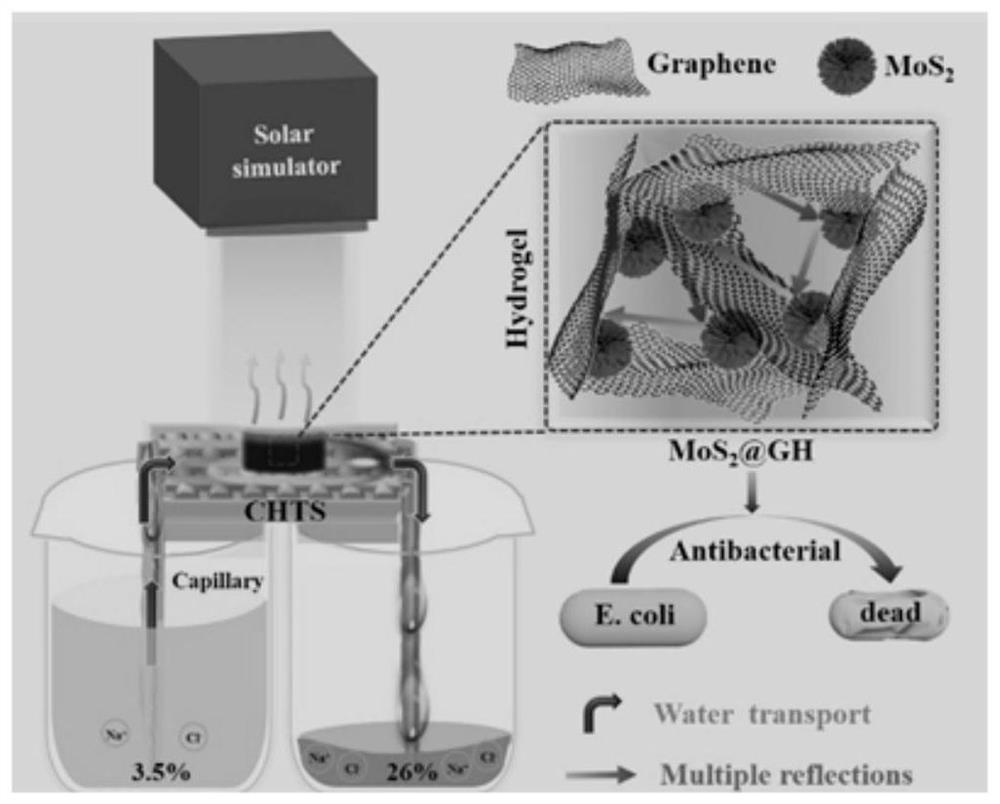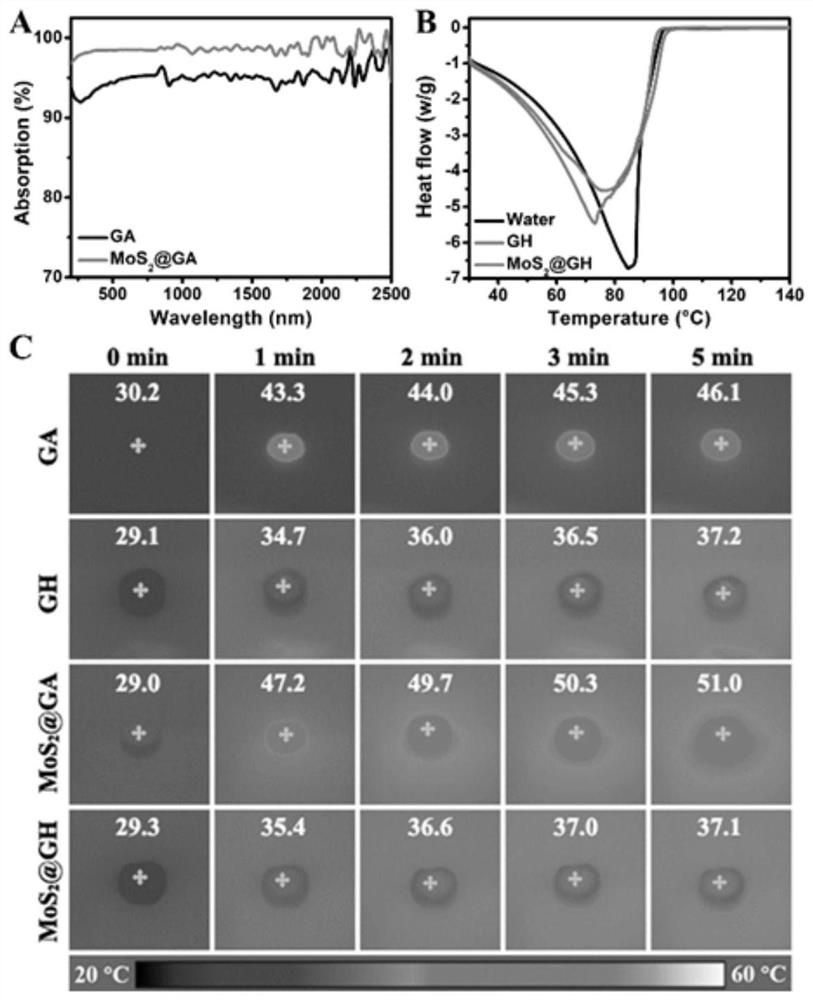Self-water-supply type photo-thermal water evaporation device based on composite hydrogel
A composite hydrogel and photothermal technology, applied in the direction of carbon compounds, molybdenum sulfide, inorganic chemistry, etc., can solve the antifouling performance of photothermal systems, resistance to salting out pollution and biological pollution, hot spots without a large number of dispersion and thermal stability Insufficiency, deficiency and other problems, to achieve the stability of anti-bacterial biofouling performance, high-efficiency seawater desalination, and reduce the effect of evaporation enthalpy
- Summary
- Abstract
- Description
- Claims
- Application Information
AI Technical Summary
Problems solved by technology
Method used
Image
Examples
Embodiment 1
[0049] Add 17 μL of 1 mol / L L-ascorbic acid to the graphene oxide solution (2 mg / mL, 1 mL), sonicate for about 10 min and then place it in an oven at 90 °C for 2 h to react. The obtained GH hydrogel is washed in deionized water, and the The corresponding airgel (GA) can be obtained by freeze-drying.
[0050] Add 4 mg of molybdenum disulfide to a solution containing 1 mL of 2 mg / mL graphene oxide, and process it with ultrasound for about 30 minutes to obtain a homogeneous mixture, then add 17 μL of 1 mol / L L-ascorbic acid, and put it in an oven at 90 ° C after ultrasound for about 10 minutes Standing in the middle for 2h, the obtained MoS 2 The @GH composite hydrogel was washed in deionized water and freeze-dried to obtain the corresponding airgel (MoS 2 @GA) spare.
[0051] Such as figure 2 Shown is the SEM (A) of the simple graphene hydrogel (GH) that the embodiment of the present invention provides, MoS 2 SEM (B), TEM (C, D), STEM (E-I) and XPS patterns (J-L) of @GH com...
Embodiment 2
[0053] Add 17 μL of 1 mol / L L-ascorbic acid to the graphene oxide solution (2 mg / mL, 1 mL), sonicate for about 10 min and then place it in an oven at 90 °C for 2 h to react. The obtained GH hydrogel is washed in deionized water, and the The corresponding airgel (GA) can be obtained by freeze-drying.
[0054] Add 8 mg of molybdenum disulfide to a solution containing 1 mL of 2 mg / mL graphene oxide, and process it with ultrasound for about 30 minutes to obtain a homogeneous mixture, then add 17 μL of 1 mol / L L-ascorbic acid, and put it in an oven at 90 ° C after ultrasound for about 10 minutes Standing in the middle for 2h, the obtained MoS 2 The @GH composite hydrogel was washed in deionized water and freeze-dried to obtain the corresponding airgel (MoS 2 @GA) spare.
[0055] Such as image 3 Shown is the MoS provided by the embodiment of the present invention 2 The optical spectrum (A), DSC curve (B) and infrared thermal image (C) of @GH composite hydrogel compared with pur...
Embodiment 3
[0057] Add 16mg of molybdenum disulfide to a solution containing 1mL of 2 mg / mL graphene oxide, and process it with ultrasound for about 60 minutes to obtain a uniform mixture, then add 17μL of 1 mol / L L-ascorbic acid, and put it in an oven at 90°C after ultrasound for about 10 minutes Standing in the middle for 2h, the obtained MoS 2 @GH composite hydrogel was washed in deionized water for later use.
[0058] Put a certain amount of blank water or NaCl solution into two beakers (25mL) to set different liquid level differences (-6mm, 0mm, 6mm, 12mm and 18mm and salt concentration differences (3.5%-0%, 3.5%-3.5 %, 3.5%–10%, 3.5%–18% and 3.5%–26% (such as the NaCl solution with a mass concentration of 3.5% in the left beaker, and the NaCl solution with a mass concentration of 26% in the right beaker, that is 3.5%–26% group), cotton gauze was used as the capillary water absorption medium, and it was constructed on two beakers to realize the rapid transfer of water and obtain a sui...
PUM
 Login to View More
Login to View More Abstract
Description
Claims
Application Information
 Login to View More
Login to View More - R&D
- Intellectual Property
- Life Sciences
- Materials
- Tech Scout
- Unparalleled Data Quality
- Higher Quality Content
- 60% Fewer Hallucinations
Browse by: Latest US Patents, China's latest patents, Technical Efficacy Thesaurus, Application Domain, Technology Topic, Popular Technical Reports.
© 2025 PatSnap. All rights reserved.Legal|Privacy policy|Modern Slavery Act Transparency Statement|Sitemap|About US| Contact US: help@patsnap.com



